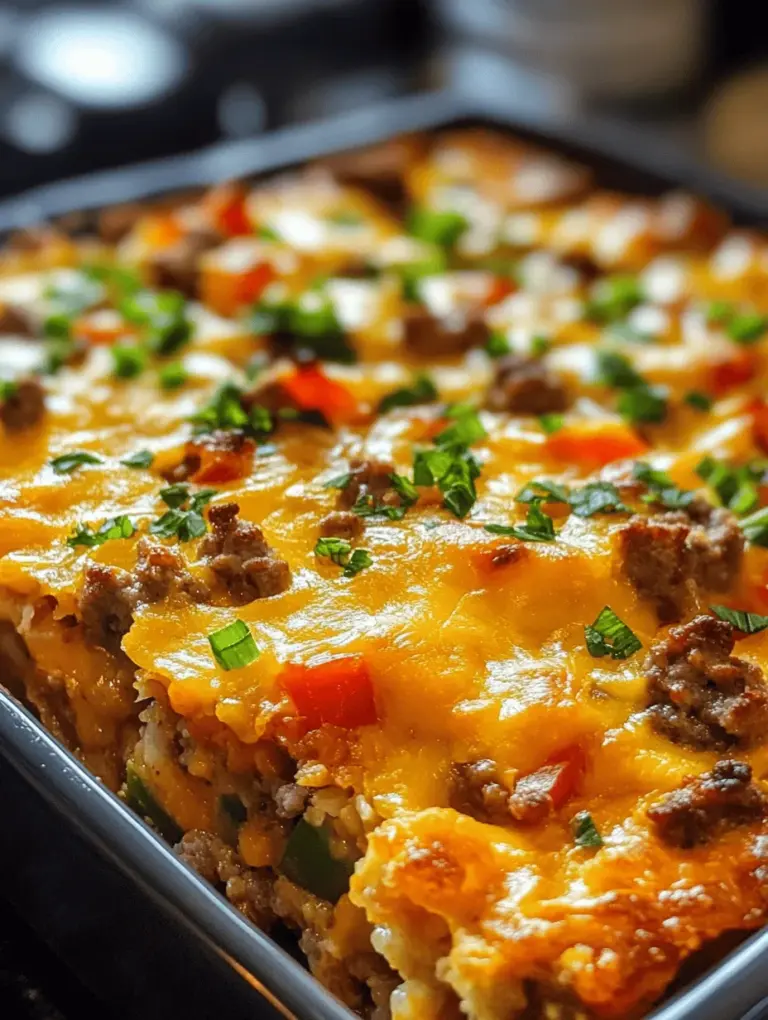Breakfast is often heralded as the most important meal of the day, and it deserves a dish that is both delicious and satisfying. Enter the Sausage Hashbrown Breakfast Casserole, a delightful and hearty dish that promises to be the star of your breakfast table. This casserole combines savory crumbled sausage, crispy hashbrowns, and a rich blend of eggs and cheese, making it an all-in-one meal that is sure to please even the pickiest of eaters. Not only is this recipe easy to prepare, but it is also incredibly versatile, allowing you to customize it to suit your personal taste preferences.
Whether you’re hosting a family gathering, organizing a brunch, or just looking for a quick and nourishing meal during a busy weekday morning, this casserole offers a satisfying start to any day. In this article, we will delve into the details of this delicious breakfast casserole, exploring its ingredients, preparation methods, variations, and tips for serving.
Understanding the Ingredients
The foundation of any great dish lies in its ingredients. To create a breakfast casserole that is both flavorful and satisfying, it’s essential to choose the right components. Let’s take a closer look at what makes this casserole truly special.
Breakfast Sausage
One of the key ingredients in this casserole is breakfast sausage. This ingredient not only adds a savory flavor but also contributes to the overall texture of the dish. When selecting sausage, you have two primary options: spicy or mild. Spicy sausage adds a kick to the casserole, while mild sausage provides a more subtle flavor profile. Depending on your audience, you can choose one over the other or even mix both for a balanced taste.
For those with dietary restrictions, there are alternatives available. Turkey sausage or plant-based sausage can be great substitutes, offering a lighter option without sacrificing flavor.
Frozen Hashbrowns
Frozen hashbrowns are another fundamental component of the Sausage Hashbrown Breakfast Casserole. They provide a crispy base that complements the other ingredients beautifully. One of the main advantages of using frozen hashbrowns is their convenience. They are pre-cooked and simply require thawing before use.
To prepare the hashbrowns, it’s important to thaw them properly to ensure they cook evenly. You can leave them in the refrigerator overnight or use the defrost setting on your microwave for quicker results. Once thawed, you can lightly pat them dry with paper towels to remove excess moisture, which helps achieve that desired crispiness during baking.
Cheddar Cheese
Cheddar cheese is a must-have in this casserole. Its sharp flavor enhances the dish while contributing a creamy texture. Using sharp cheddar cheese is recommended for the best flavor, but you can experiment with other types of cheese to add a unique twist. Consider using Monterey Jack for a milder taste or pepper jack if you want to infuse a bit of heat.
Vegetables: Bell Peppers and Onions
Adding vegetables such as bell peppers and onions not only enhances the flavor but also boosts the nutritional value of the casserole. Bell peppers are rich in vitamins A and C, while onions provide antioxidants and anti-inflammatory properties.
You can sauté these vegetables together with the sausage for optimal flavor. If you’re looking to mix things up, consider adding spinach, mushrooms, or even zucchini for an extra veggie boost.
Eggs and Milk
The role of eggs in this casserole is crucial as they serve to bind all the ingredients together. They also create a custard-like texture that makes each bite satisfying. When it comes to the type of milk to use, whole milk is recommended for creaminess, but you can substitute it with low-fat or dairy-free alternatives if needed.
Seasonings: Garlic Powder, Onion Powder, Salt, and Pepper
Seasonings are the final touch that elevates the flavor profile of your casserole. Basic seasonings like garlic powder, onion powder, salt, and pepper can be adjusted to your liking. If you enjoy a bit of heat, consider adding red pepper flakes or even a dash of hot sauce to the egg mixture. Customizing your seasoning blend allows you to create a dish that truly reflects your taste preferences.
Preparation Steps Explained
Once you have gathered all your ingredients, understanding the preparation steps is essential for achieving the perfect casserole. Here are the key steps to follow:
Prepping the Baking Dish
Before you start cooking, it’s important to prep your baking dish. Greasing the dish with butter or non-stick spray is crucial as it prevents the casserole from sticking, making it easier to serve. A 9×13-inch baking dish is ideal for this recipe, providing ample space for all the ingredients.
Cooking the Sausage
Start by cooking the breakfast sausage in a skillet over medium heat. Break the sausage into small crumbles as it cooks, ensuring even browning. This process typically takes about 5-7 minutes. Once the sausage is browned and cooked through, it’s essential to drain any excess fat to keep the casserole from becoming greasy. Simply transfer the cooked sausage to a paper towel-lined plate to absorb the excess oil.
Sautéing Vegetables
After cooking the sausage, it’s time to sauté the vegetables. In the same skillet, add the diced bell peppers and onions. Sauté them for about 3-4 minutes or until they are tender and slightly caramelized. This step is crucial as it brings out the natural sweetness of the vegetables while preserving their texture.
Timing is key here; adding the vegetables to the sausage after it has cooked allows them to soak up the flavorful drippings left in the pan.
Whisking the Egg Mixture
While the vegetables are sautéing, you can prepare the egg mixture. In a large bowl, whisk together the eggs and milk until well combined. Achieving the right consistency in the egg mixture is essential for a fluffy casserole. Incorporating air while whisking helps create a light texture. You can season this mixture with salt, pepper, and any additional spices you prefer.
Layering the Casserole
With all your components ready, it’s time to assemble the casserole. Start by layering the thawed hashbrowns evenly on the bottom of the greased baking dish. Follow this with an even distribution of the cooked sausage and sautéed vegetables. Finally, pour the egg mixture over the top, ensuring that it seeps through the layers. Top with shredded cheddar cheese for that melty, golden finish.
Now that you have a clear understanding of the ingredients and steps involved in preparing the Sausage Hashbrown Breakfast Casserole, you’re well on your way to creating a dish that will impress your family and friends. This versatile breakfast option is perfect for any occasion, and with a few simple tweaks, you can make it uniquely yours. Stay tuned as we explore variations, serving tips, and more!
{{image_1}}
Best Practices for Layering Ingredients for Even Cooking
Layering ingredients properly is crucial for ensuring that your Sausage Hashbrown Breakfast Casserole cooks evenly and thoroughly. Start by distributing the hashbrowns evenly across the bottom of your baking dish. This forms the base layer and helps absorb excess moisture from the other ingredients.
Next, add the cooked sausage, ensuring it’s evenly spread over the hashbrowns. This allows the flavors to meld beautifully as it bakes. Follow this with a layer of your chosen vegetables, such as bell peppers or onions, which will add texture and flavor.
When it comes to the egg mixture, pour it slowly and evenly over the entire casserole. This ensures that each layer absorbs the egg mixture well, allowing for a cohesive texture throughout the dish. Finally, sprinkle cheese generously on top. Not only does this add flavor, but it also creates a deliciously golden crust as it bakes.
Visual Presentation of Layers
Visual presentation is key to an appealing casserole. Consider using a clear baking dish to showcase the beautiful layers of your casserole. The contrasting colors of the yellow eggs, golden hashbrowns, and vibrant vegetables can make the dish visually enticing. If using a ceramic or glass dish, be sure to lightly grease it to prevent sticking, as this will help maintain the integrity of the layers when serving.
Once baked, the casserole should have a beautiful crust on top, with the ingredients peeking through. If you wish to enhance the visual appeal further, consider adding a sprinkle of fresh herbs like parsley or chives before serving.
Baking the Casserole
Understanding Baking Times and Temperatures
Baking the casserole properly is essential for achieving the perfect texture. Preheat your oven to 375°F (190°C) before placing your casserole inside. This temperature is ideal for cooking the casserole through without burning the top.
Typically, the casserole will need to bake for about 45-55 minutes. However, keep in mind that oven temperatures can vary. It’s always a good idea to check the casserole a few minutes before the expected cooking time.
Signs that the Casserole is Ready to Be Removed from the Oven
To determine if your casserole is ready, look for a few key signs. The top should be golden brown and slightly crispy, while the center should be firm to the touch. You can also insert a knife or toothpick into the center; if it comes out clean or with only a few crumbs, your casserole is done. Additionally, the edges should begin to pull away slightly from the sides of the dish.
Cooling and Serving
The Importance of Letting the Casserole Cool
After removing the casserole from the oven, allow it to cool for at least 10-15 minutes before slicing. This resting period allows the layers to set, making it easier to cut and serve, and helps prevent the filling from spilling out. Cooling also enhances the flavor as it allows the ingredients to meld together.
Suggestions for Slicing and Serving
When it’s time to serve, use a sharp knife to cut the casserole into squares or wedges. A pie server or spatula can help lift the pieces without breaking them apart. For an added touch, serve with a dollop of sour cream or a sprinkle of fresh herbs on top for a burst of freshness.
Nutritional Information
A Breakdown of the Nutritional Content of the Sausage Hashbrown Breakfast Casserole
Understanding the nutritional content of your Sausage Hashbrown Breakfast Casserole can help you make informed choices. Here’s a general breakdown of the nutritional profile per serving, assuming a recipe that serves eight:
– Calories: Approximately 300-350 calories
– Protein: 16-20 grams
– Fat: 18-24 grams
– Carbohydrates: 25-30 grams
– Fiber: 2-4 grams
This casserole provides a balanced mix of macronutrients, making it a hearty breakfast option.
Calories and Macronutrients
– Total Calories per Serving: Approximately 325 calories
– Protein: 18 grams
– Fats: 22 grams
– Carbohydrates: 27 grams
This balance of macronutrients makes the casserole a filling and energizing meal choice, perfect for starting your day.
Health Considerations
Tips for Making the Casserole Healthier
To make your Sausage Hashbrown Breakfast Casserole a bit healthier, consider these tips:
– Use Lean Sausage: Opt for turkey or chicken sausage instead of pork to reduce fat content.
– Incorporate More Vegetables: Add more vegetables like spinach, zucchini, or tomatoes to increase fiber and nutrients without significantly changing the flavor.
– Choose Whole Grain: If possible, use whole-grain hashbrowns for added fiber and nutrients.
Potential Allergens and Substitutes
Be aware of common allergens in this recipe, such as dairy and gluten. You can make this casserole gluten-free by using gluten-free hashbrowns. For dairy-free options, consider using plant-based milk and cheese alternatives. If you or your guests have specific dietary needs, always offer substitutes or clearly label the dish.
Variations and Customizations
Exploring How to Modify the Recipe to Suit Different Tastes and Dietary Preferences
One of the best aspects of the Sausage Hashbrown Breakfast Casserole is its versatility. You can easily adapt this dish to accommodate various tastes and dietary preferences. Here are some ideas:
Vegetarian Options
For a delicious vegetarian version, simply omit the sausage and replace it with extra vegetables such as mushrooms, spinach, or bell peppers. You could also add plant-based sausage or tofu for added protein.
Recommended Substitutes for Sausage
If you’re looking for a sausage substitute, there are many options available on the market today. Consider using:
– Tempeh or Tofu: Crumble and sauté with spices to mimic the flavor of sausage.
– Vegetarian Sausages: These often come pre-seasoned and can be directly substituted.
Spicy Twist
For those who enjoy a bit of heat, adding jalapeños or a splash of hot sauce can elevate the flavors of your casserole. Jalapeños can be diced and sprinkled throughout the layers, or you can mix them directly into the egg mixture for a more uniform heat.
Pairing Flavors that Complement Spiciness
When adding heat, consider pairing it with cooling elements like avocado or a yogurt-based sauce. This contrast can enhance the overall flavor profile and provide a balanced meal.
Cheese Alternatives
Experimenting with different cheese varieties can also yield exciting results. Consider using:
– Pepper Jack: For an extra kick.
– Feta or Goat Cheese: These cheeses offer a tangy flavor that pairs well with the richness of the casserole.
Vegan Cheese Options for Lactose Intolerance
If you’re preparing this dish for someone with lactose intolerance, there are numerous vegan cheese options available, including cashew-based or almond-based cheeses. These can melt similarly to traditional cheese and provide a creamy texture.
Serving Suggestions
Ideas for Complementing the Casserole and Creating a Complete Breakfast Experience
To create a well-rounded breakfast experience, consider pairing your Sausage Hashbrown Breakfast Casserole with:
– Fresh Fruit: A fruit salad or sliced seasonal fruits can add brightness and freshness.
– Toast or Bagels: These can serve as a vehicle for any toppings like cream cheese or avocado.
– Yogurt: A side of yogurt can provide additional protein and a creamy texture that complements the casserole.
Pairing with Sides
Recommended side dishes that work well with the casserole include:
– Sautéed Greens: Like spinach or kale for added nutrients.
– Hashbrowns: If you’re a hashbrown enthusiast, serve additional crispy hashbrowns on the side.
Beverage Pairings
Beverages can enhance your breakfast experience. Consider:
– Coffee: A classic choice for many breakfast tables.
– Fresh Juices: Orange juice or green smoothies can add a refreshing kick.
– Herbal Tea: A calming way to start the day.
Presentation Ideas
Creative Ways to Serve the Casserole
Presentation is key to making any meal inviting. Consider serving your casserole directly from the baking dish, or transfer individual portions to colorful plates for a more refined look.
Garnishing Tips for an Appealing Look
To elevate the presentation, garnish with:
– Fresh Herbs: Chopped parsley, chives, or cilantro can add a pop of color.
– Avocado Slices: Placed on the side, they offer a creamy counterpoint to the casserole’s richness.
– Sour Cream or Greek Yogurt: A dollop on top adds creaminess and can be swirled for an elegant touch.
Conclusion
The Sausage Hashbrown Breakfast Casserole is not just a meal; it’s a comforting experience that can be enjoyed by everyone. With its rich flavors, comforting texture, and adaptability to various dietary needs, it’s a versatile choice for any breakfast occasion. Whether you’re hosting a brunch or simply feeding your family on a busy morning, this casserole is sure to impress. By following the preparation steps and exploring the variations, you can create a dish that suits your taste and brings smiles to the breakfast table. Enjoy the warmth and satisfaction that this delightful casserole brings, making every morning a little bit brighter.


